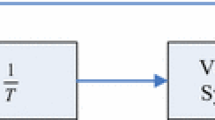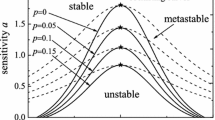Abstract
In order to study the traffic jams and congestion and to understand the forming process of traffic congestion. On the basis of synchronization theory of complex network, this paper investigated the stability of an extended car-following model under honk environment. By using the Lyapunov stability theory and designing the appropriate controller, the car-following model is quickly stabilized and the stability condition of the model is obtained. In addition, the stability of the extended car-following model under honk environment is studied when the vehicle is subjected to external disturbance. Finally, the effects of the designed controller on the stability of the extended car-following model under honk environment and the influence of honk effect on the traffic flow are verified by using the Matlab simulation technology. The conclusions of this paper can provide a theoretical reference for the prevention and control of traffic congestion.




Similar content being viewed by others
Explore related subjects
Discover the latest articles, news and stories from top researchers in related subjects.References
Gipps, P.G.: A behavioural car-following model for computer simulation. Transp. Res. B Methodol. 15(2), 105–111 (1981)
Chakroborty, P., Kikuchi, S.: Evaluation of the general motors based car-following models and a proposed fuzzy inference model. Transp. Res. Part C: Emerging Technologies. 7(4), 209–235 (1999)
He, G.G., Wan, X.Y.: Simulation research on evaluating of reasonability for the Car-following models based on Chaos criterion. Syst. Eng.-Theory Pract. 24(4), 122–129 (2004)
Ge, H.X., Meng, X.P., Ma, J., Lo, S.M.: An improved car-following model considering influence of other factors on traffic jam. Phys. Lett. A. 377(1–2), 9–12 (2012)
Tang, T.Q., Li, J.G., Huang, H.J., Yang, X.B.: A car-following model with real-time road conditions and numerical tests. Measurement. 48(48), 63–76 (2014)
Przybyla, J., Taylor, J., Jupe, J., Zhou, X.: Estimating risk effects of driving distraction: a dynamic errorable car-following model. Transp. Res. Part C: Emerging Technologies. 50, 117–129 (2015)
Kendziorra, A., Wagner, P., Toledo, T.: A stochastic Car following model. Transp. Res. Proc. 15, 198–207 (2016)
Li, L., Chen, X.Q., Zhang, L.: A global optimization algorithm for trajectory data based car-following model calibration. Transp. Res. Part C: Emerging Technologies. 68, 311–332 (2016)
Wang, J., Rakha, H.A., Fadhloun, K.: Validation of the Rakha-Pasumarthy-Adjerid car-following model for vehicle fuel consumption and emission estimation applications. Transp. Res. Part D: Transport & Environment. 55, 246–261 (2017)
Du, W. J., Li, Y. Z., Zhang, J. G., Yu, J. N.: Stability analysis of a general nonlinear car-following model. Int. J. Control. 93(6), 1461–1469 (2020)
Sun, D. H., Li, Y. F., Tian, C.: Car-following model based on the information of multiple ahead & velocity difference. Syst. Eng.-Theory Pract. 30(7): 1326-1332(2010)
Orosz, G., Krauskopf, B., Wilson, R.E.: Bifurcations and multiple traffic jams in a car-following model with reaction-time delay. Physica D: Nonlinear Phenomena. 211(3), 277–293 (2004)
Xia, D.X., Li, C.G.: Hydrodynamic model for two-lane traffic flow considering the information of multi-vehicles ahead and lateral vehicles. Syst. Eng.-Theory Pract. 32(7), 1562–1567 (2012)
Yu, S., Shi, Z.: An extended car-following model considering vehicular gap fluctuation. Measurement. 70, 137–147 (2015)
Zhai, C., Wu, W.: A new car-following model considering driver’s characteristics and traffic jerk. Nonlinear Dyn. 3, 1–15 (2018)
Qin, Y.Y., Wang, H., Ran, B.: Car-following model of connected and autonomous vehicles considering multiple feedbacks. J. Transp. Syst. Eng. Inform. Technol. 18(3), 48–54 (2018)
Tang tieqiao, Li chuanyao, Huang Haijun, et al.: An extended optimal velocity model with consideration of honk effect. Commun. Theor. Phys. 54(12), 1151–1155 (2010)
Wen, H., Rong, Y., Zeng, C., Qi, W.: The effect of driver’s characteristics on the stability of traffic flow under honk environment. Nonlinear Dyn. 84(3), 1517–1528 (2016)
Kuang, H., Xu, Z.P., Li, X.L., Lo, S.M.: An extended car-following model accounting for the honk effect and numerical tests. Nonlinear Dyn. 87(1), 149–157 (2017)
Kuang, H., Xu, Z.P., Li, X.L., Lo, S.M.: An extended car-following model accounting for the average headway effect in intelligent transportation system. Physica A: Statistical Mechanics and its Applications. 471, 778–787 (2017)
Arenas, A., Díaz-Guilera, A., Kurths, J., Moreno, Y., Zhou, C.: Synchronization in complex networks. Phys. Rep. 469(3), 93–153 (2008)
Tang, H., Chen, L., Lu, J., Tse, C.K.: Adaptive synchronization between two complex networks with nonidentical topological structures. Physica A: Statistical Mechanics and its Applications. 387(22), 5623–5630 (2008)
Jiang, S., Cai, G., Cai, S., Tian, L., Lu, X.: Adaptive cluster general projective synchronization of complex dynamic networks in finite time. Commun. Nonlinear Sci. Numer. Simul. 28(1), 194–200 (2015)
Li, K., Sun, W., Small, M., Fu, X.: Practical synchronization on complex dynamical networks via optimal pinning control. Phys. Rev. E. 92(1), 010903 (2015)
Wang, Y., Li, T.: Synchronization of fractional order complex dynamical networks. Physica A: Statistical Mechanics and its Applications. 428, 1–12 (2015)
Jian-Rui, C., Li-Cheng, J., Jian-She, W., Xiao-Hua, W.: Adaptive synchronization between two different complex networks with time-varying delay coupling. Chin. Phys. Lett. 26(6), 060505 (2009)
Sun, M., Zeng, C., Tian, L.: Linear generalized synchronization between two complex networks. Commun. Nonlinear Sci. Numer. Simul. 15(8), 2162–2167 (2010)
Shen, D., Li, J.H., Xiong, J.S., et al.: A cascading failure model of double layer complex networks based on betweenness. Compl. Syst. Compl. Sci. 11(3), 12–18 (2014)
Yu, K., Rong, L. L., Wang, J. W.: A new attack on scale-free networks based on cascading failures. Mod. Phys. Lett. B. 23(20), 2497-2505(2009)
Ma, J., Han, W., Guo, Q., Zhang, S., Wang, J., Wang, Z.: Improved efficient routing strategy on two-layer complex networks. International Journal of Modern Physics C. 27(04), 1650044 (2016)
Tang, T.Q., Li, C.Y., Wu, Y.H., Huang, H.J.: Impact of the honk effect on the stability of traffic flow. Physica A: Statistical Mechanics and its Applications. 390(20), 3362–3368 (2011)
Acknowledgments
This work was supported by the National Natural Science Foundation of China (Nos. 61863022, 11962012), Natural Science Foundation of Gansu Province (No. 20JR5RA422), Lanzhou Jiaotong University Youth Scientific Research Fund Project (No. 2018020).
Conflict of Interest
The authors declare that they have no conflicts of interest.
Author information
Authors and Affiliations
Corresponding author
Additional information
Publisher’s Note
Springer Nature remains neutral with regard to jurisdictional claims in published maps and institutional affiliations.
Rights and permissions
About this article
Cite this article
Du, W., Li, Y. & Zhang, J. Stability Analysis and Control of an Extended Car-Following Model under Honk Environment. Int. J. ITS Res. 20, 1–10 (2022). https://doi.org/10.1007/s13177-021-00267-0
Received:
Revised:
Accepted:
Published:
Issue Date:
DOI: https://doi.org/10.1007/s13177-021-00267-0




